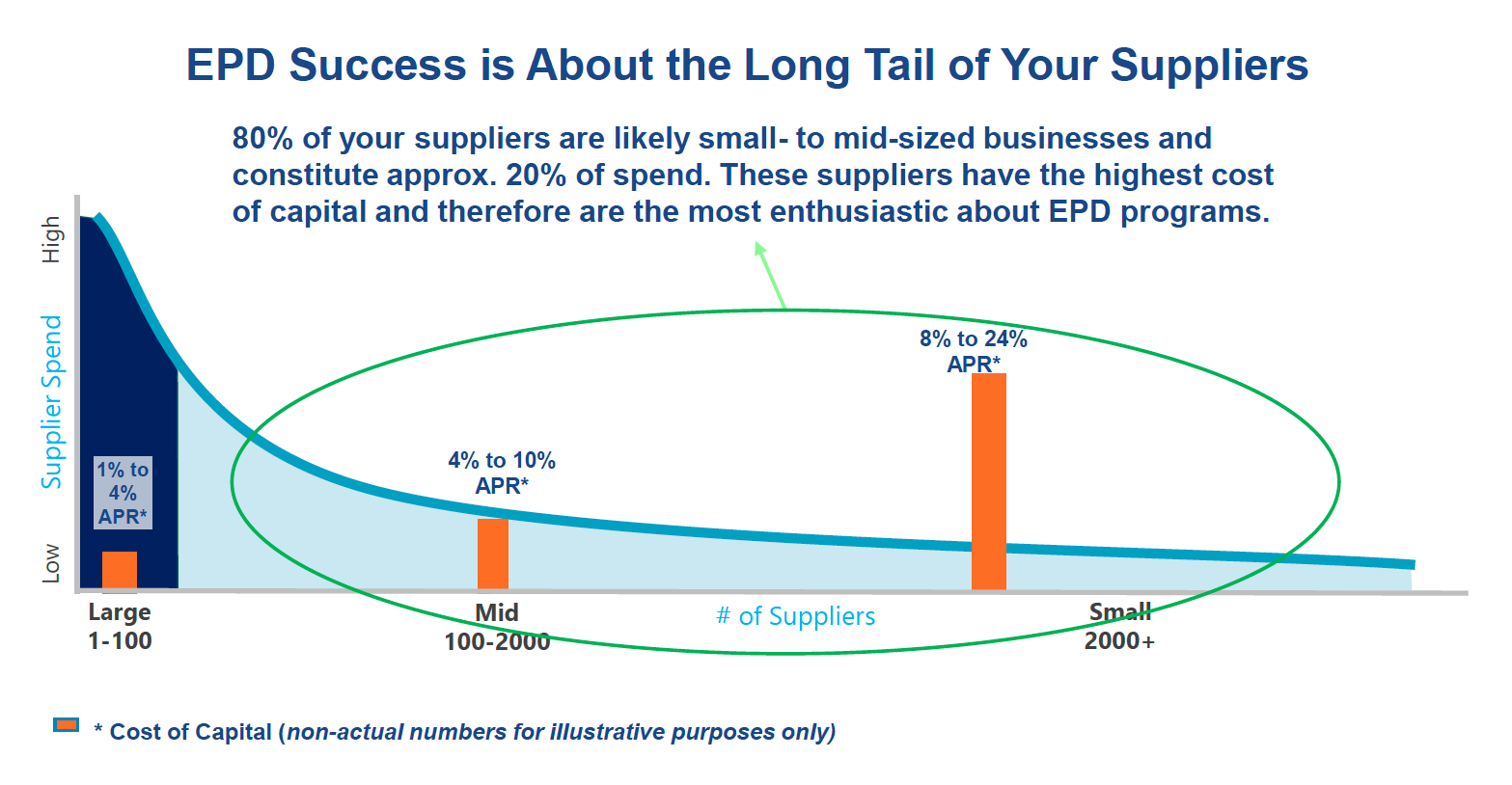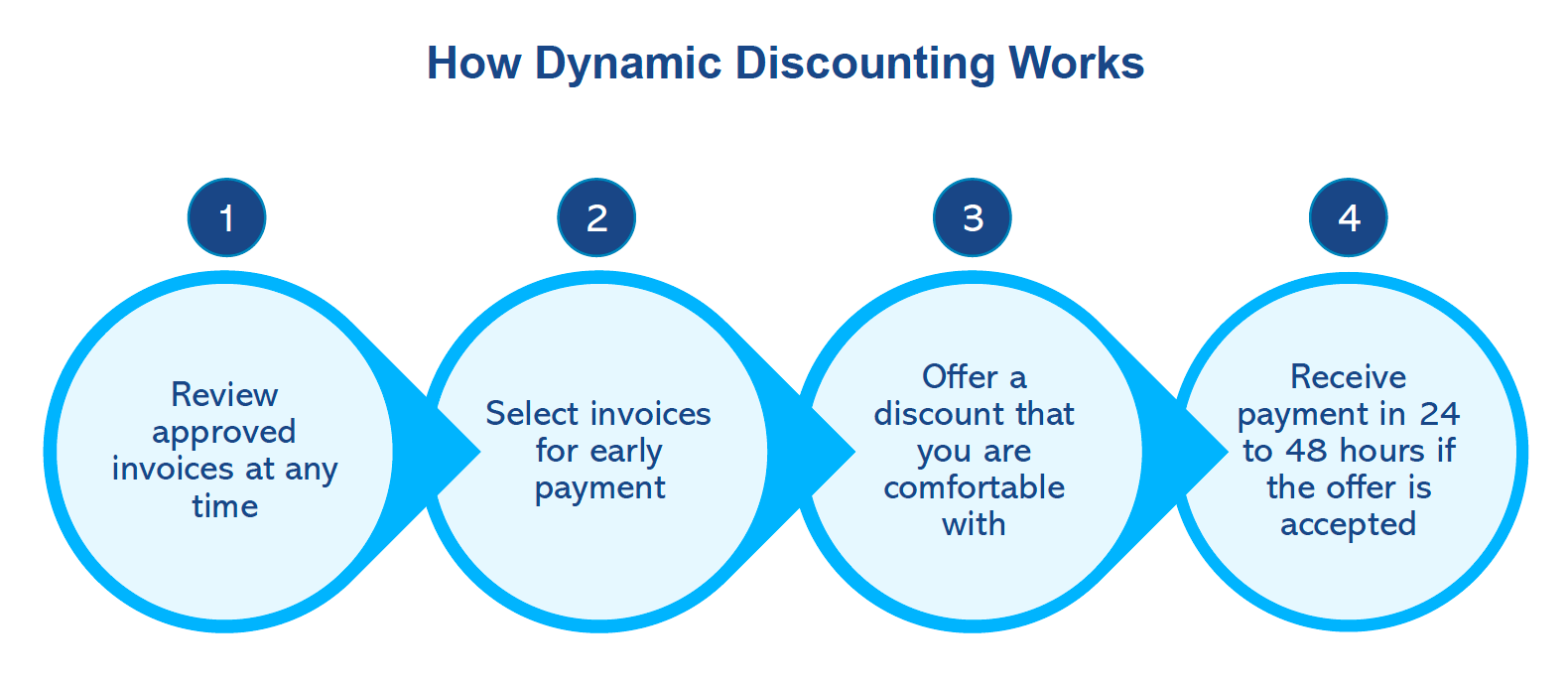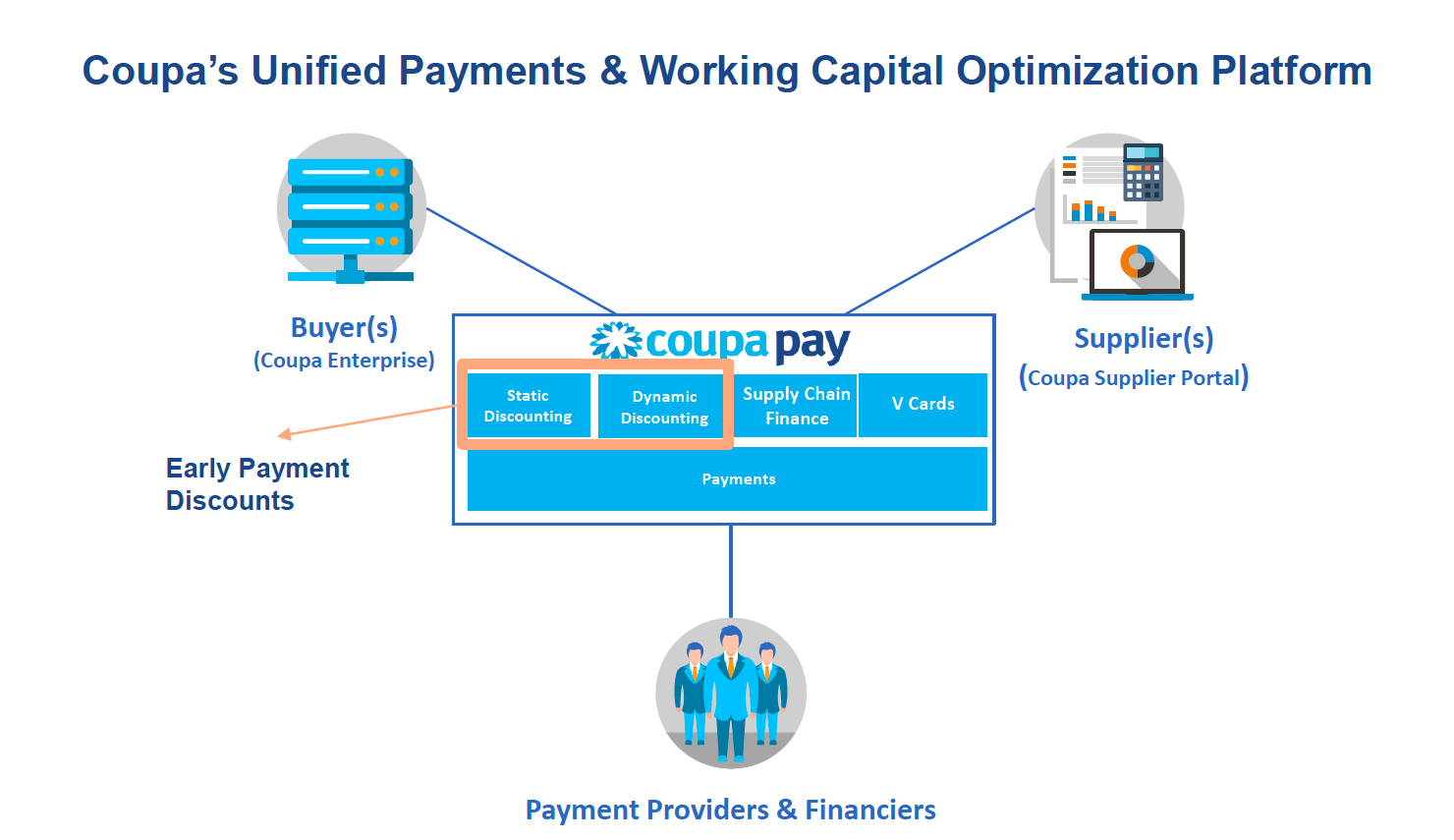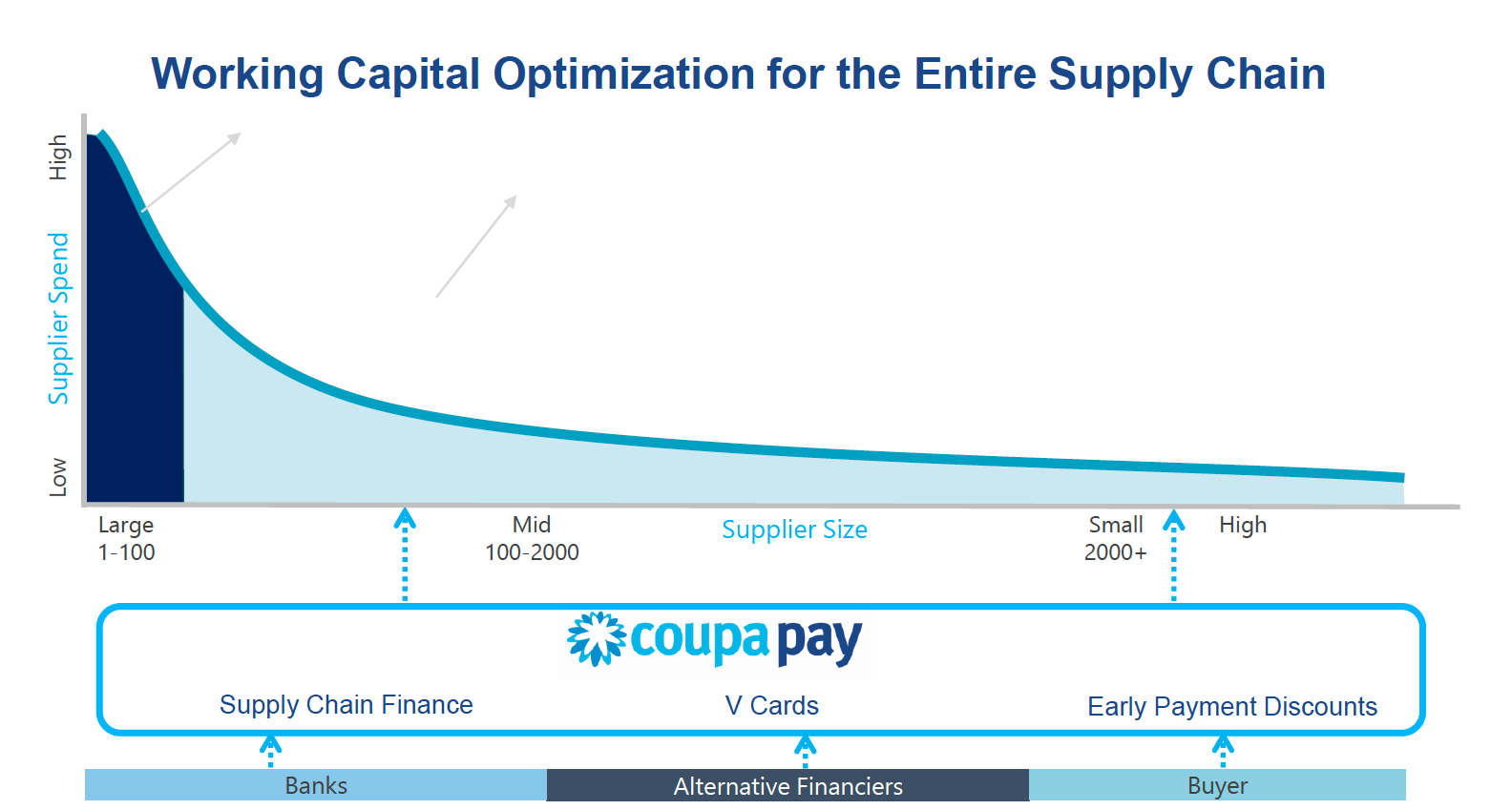How to Succeed with Early Payment Discount Programs

With Treasury rates at record lows, many treasury departments are looking for short-term, risk-free investments for excess cash. Early payment discounts (EPD) may offer the best ROI on cash—often capable of generating 8% to 16% APR, an incredible yield for today’s low-rate environment. At the same time, the global COVID-19 pandemic has put unprecedented pressures on suppliers, leaving many with liquidity issues. This poses a threat to the enterprise supply chain and business continuity. All in all, this is an ideal time to offer a comprehensive early payment discount program to suppliers.
[Looking for insights on how to improve your cash flow, protect your supply chain, and increase agility Download the new eBook, Rethinking Working Capital Management and Payments]
Why You Need EPD for All Suppliers, Including Small- to Mid-Size Businesses
EPD programs typically focus on a few large suppliers. While large suppliers might constitute a big portion of the company’s spend, rarely do they offer large discounts. Large suppliers have various financing options and therefore little incentive to take a discount for early payment. The Pareto Principle (80-20 rule) applies to supply chains too—that is, 80% of suppliers constitute 20% of spend. These suppliers, frequently several thousand in number, are the small- and mid-size suppliers that make up the “long tail” (80%) of the supplier base. It is these long-tail suppliers that can drive success of EPD programs.

Small- to mid-size suppliers have smaller invoices, but when aggregated, they constitute 20% of spend—a non-trivial portion. These suppliers have fewer financing options, and their cost of financing is high. While large suppliers can obtain financing at 1% to 4% APR, the cost of financing for many smaller suppliers ranges between 8% and 18%. Because the liquidity pressures on these suppliers are even higher than those on larger suppliers, these smaller businesses are more likely to benefit from early payment discounts that support their cash flow.
Many enterprises can efficiently manage EPD manually for the top 10 to 20 percent of their suppliers. However, this approach misses the 80 percent of suppliers who stand to gain the most from it. For an EPD program to benefit both buyers and suppliers, it should target all suppliers.
Optimize Working Capital, Improve Managed Spend, and Support All Suppliers
Managing an EPD program at scale is challenging. Typically, EPD programs start with a procurement team identifying suppliers for an early payment program during new supplier sourcing or review of existing suppliers. Next comes negotiating a contract for early payments, and then AP paying out to suppliers upon invoice submission per the terms of the contract, often within days. This cumbersome manual process is certainly not scalable.
Today’s technology platforms for EPD programs automate some of these manual processes, but that solves only part of the problem. Modern solutions that integrate EPD programs into efficient spend management and payment processes—with effective on-boarding programs that can reach out to all suppliers—provide EPD at scale, optimizing working capital for both buyers and suppliers.
Below, we walk through the various kinds of early payment programs, the challenges they entail, and our approach to overcoming the challenges.
How EPD Programs Work: Static vs Dynamic Discounting
Programs for early payment discounts (also called prompt pay discounts) enable a buyer to receive a discount for paying a supplier early. Suppliers appreciate getting paid fast, which helps with their cash flow. Smaller suppliers especially benefit from early access to payments. Buyers benefit both by supporting critical suppliers and by earning a better return on available working capital.
Modern EPD structures include static discounting and dynamic discounting.
In static discounting, the company offers pre-defined early payment terms to the supplier. The supplier can choose one of these early payment terms at invoice creation. For example, you might offer 1%/10 net 30 as a payment term, meaning that if the supplier is paid within the first 10 days, then the buyer can take a 1% discount. Static discounting works well for suppliers who know that they want early payment and are submitting invoices through a portal where they can choose the payment term.
Dynamic discounting is a more collaborative form of setting EPD terms. A supplier submits an offer for early payment any time after invoice approval, and the supplier can choose to offer any discount rate. The flexibility to offer a discount at any time and to choose any discount rate is what makes this arrangement dynamic.

Allowing suppliers to bid with any offer allows price discovery: determining the price of an asset in the marketplace through the interactions of buyers and sellers. Supplier participation is high since suppliers have time to request a discount and they get to offer the discount rate they’re willing to accept.
3 Challenges of Implementing EPD Programs
The most important challenges for enterprises deploying EPD programs include discovery of who needs early payment, adoption of the program, and siloed technology systems and processes. Many EPD programs haven’t succeeded because a siloed approach to managing business spend makes it impossible to do core EPD tasks at scale.
- Discovery: How do you identify which suppliers need an early payment in return for a discount? The first challenge in launching an EPD program is discovering which suppliers—from the largest to the smallest—need an early payment discount and are willing to accept it, when they need it, and what discount rate they are willing to offer. A manual approach to contacting suppliers and asking if they want early payment is simply not scalable. In addition, suppliers’ needs for early payments are constantly changing. They may need it today but then not next month. A technology platform that allows suppliers to easily indicate that they want early payment in return for a discount is critical to discovering who needs early payment.
- Supplier adoption: How do you make it easy for suppliers to submit a request for early payment? Let’s say you are ready to offer a prompt pay discount program, and you’ve identified the suppliers you want to offer the program to. The next challenge is getting suppliers to sign up for the program and submit an early payment offer when they need cash. With just a few suppliers, this could be done manually. But with hundreds or thousands of suppliers, siloed technology platforms, and manual paper-based workflows, it will be impossible to deploy and manage a successful EPD program at scale. Supplier adoption at scale depends on the right systems, enablement tools, and on-boarding programs.
- Integrated, automated spend and payment processes: How do you manage offers and make payments efficiently at scale? Treasury, AP, and fulfillment teams—and their systems—are often fragmented with siloed processes and datasets. Many corporations have one or more systems that store supplier information plus one or more systems for invoice approval, and often a separate system for payments. From an Ops perspective, such siloed systems make it exceedingly difficult to deploy and manage prompt pay discounts and other working capital optimization programs, especially with legacy payment processes. On top of that, many AP teams do not have the time, resources, or systems to optimize payment timing to manage and deliver on EPD programs. Without a comprehensive system to make prompt-pay-discount offers to suppliers in need at the right time—including the ability to accelerate invoice processing and payment—programs are stymied by a mismatch between offers and suppliers who need help with liquidity.
Key Pillars of a Successful Early Payment Discounts Program
- Supplier segmentation: You need the ability to create customized EPD programs based on supplier segments. For example, you might want to set different return objectives based on supplier size, etc.
- Supplier enablement: Buyers must show suppliers the value of adopting early payment discounts and support the process with automated engagement and easy onboarding.
- Choice and flexibility: In general, the more choice and flexibility a buyer can offer suppliers, the higher the participation rate of suppliers will be, which is essential to EPD program success.
- Integrated technology systems: You need systems that are easy to use for buyers and suppliers. Buyers need controls to activate programs, segment, engage, and optimize, as well as speed of settlement.
How Business Spend Management Overcomes the Challenges of EPD Programs
Business Spend Management (BSM) is a unified set of business processes supported by software and the cloud that encompass procurement, invoice management, and expense management—all the ways organizations spend money. In addition, truly comprehensive BSM spans the related processes of contract lifecycle management, supplier information management, inventory management optimization, advanced sourcing, budgeting, and analytics. A modern BSM platform supports the four key pillars of EPD success:
- Segmentation—BSM gives buyers the ability to segment their suppliers at scale efficiently so that they can create customized EPD programs to meet the needs and goals of different supplier segments, including long-tail suppliers.
- Enablement—Because a BSM platform provides integrated and automated capabilities that offer engagement, enablement, choice, and flexibility to suppliers, it dramatically increases supplier adoption of EPD programs, which is critical to EPD program success.
- Choice and Flexibility—BSM provides systems that allow buyers to easily set up a range of EPD programs, while also enabling suppliers to participate in programs with a range of choices to meet varied needs.
- Technology—Modern BSM technology platforms provide the backbone for easy integration of early payment discounts directly into the flow of everyday transactions. Their powerful capabilities make it easy to set up, manage, monitor, and optimize EPD programs across your entire supplier base.
[Get the most value out of your AP, supplier management, and payments strategies with a new model for driving efficiency, optimizing cash flow, and mitigating risk by accessing our eBook, Rethinking AP Automation and Payments]
Maximize the Value of EPD Programs with Coupa Pay
Coupa Pay, part of Coupa’s industry leading BSM platform, provides an all-in-one payment and working capital optimization solution. Coupa Pay features built-in processes that support flexible, automated early payment discount programs, giving companies an end-to-end P2P process.
Coupa Pay offers a suite of solutions for working capital optimization including early payment discounts—as well as virtual credit cards (vCards) and supply chain financing (SCF)—all available and integrated into spend-transaction flow. Built-in, automated supplier engagement and on-boarding assure the high supplier participation necessary for successful EPD programs. These capabilities enable buyers to set up and manage a robust solution that serves both the buyer and its suppliers.
Coupa Pay’s all-in-one payment solution also includes ACH, cross border payments, and digital checks. A successful EPD program requires that, once the offer for early payment is accepted, the payment be made promptly, ideally within 24 to 48 hours. By unifying payments with early payment discounts and business spend management processes, Coupa provides the only solution that integrates all the traditionally siloed processes.

- Putting Buyers in Control: With Coupa Pay, buyers get centralized control over the discounting process, built-in supplier enablement, and integrated payments. Buyers easily create customized, prompt pay programs by setting a minimum desired APR, the amount of committed funds, the timescale (e.g., quarter), plus days to pay and minimum discount days. Buyers then select and approve suppliers to participate in the program.
- Flexible, Automated Dynamic Discounting: When an invoice is approved, suppliers receive an email with a Pay Me Now button. The supplier can make a discount offer with just a few clicks and receive immediate feedback on acceptance or refusal. Suppliers can also set discount preferences to apply to all invoices going forward. Similarly, if suppliers are creating invoices in Coupa, they can choose an early payment discount payment term when the invoice is created.
- Requesting Early Payment at Any Time During a Transaction: Coupa’s early payment discounting allows prompt pay discounts to be applied at any point in the transaction. A supplier can request early payment at the time of PO issuance, at the time of invoice submission, or at any point before the invoice is paid.
- Community Intelligence Support for Fine-Tuning Programs: With Coupa’s community intelligence, enterprises have access to KPIs and peer benchmarks that help managers monitor and fine-tune program adoption and operational efficiency. Coupa also delivers proactive recommendations built upon community data, ML, and AI that help drive ongoing EPD program improvements.
- EPD Programs Supported by BSM for Working Capital Optimization: With the increasing need for optimizing working capital, as well as supporting critical suppliers who may be struggling, EPD programs—as part of an overall working capital optimization solution—are more important than ever.

Coupa’s BSM platform overcomes all the traditional challenges of successfully implementing, managing, and optimizing early payment discount programs that will improve your bottom line, support your critical suppliers, and add resiliency to your supply chain. Coupa is the leading BSM platform that enables EPD programs, as well as SCF and vCards, which together offer a comprehensive working capital optimization solution.
